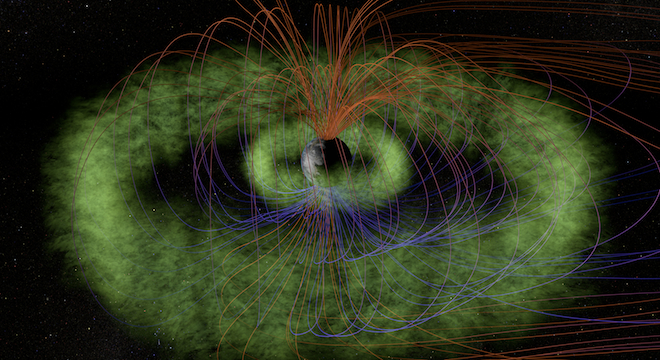Earth is singing to space, and its song sounds a bit like sonar.
NASA on Monday announced the release of what it said was the clearest recording yet of “chorus,” the audio version of the radio signals emitted by the plasma waves in our planet’s Van Allen radiation belts.
“This is what the radiation belts would sound like to a human being if we had radio antennas for ears,” said Craig Kletzing, a physics professor at the University of Iowa, who was in charge of the team that built the NASA instrument that recorded the sound, in a NASA press release.
Listen to the mp3 file here.
Earth-chorus-EMFISIS by carlfranzen
The instrument Kletzing and his colleagues designed to capture the chorus, the Electric and Magnetic Field Instrument Suite and Integrated Science (EMFISIS) receiver, is one of two identical such pieces of equipment, each attached to one of the twin NASA Radiation Belt Storm Probes, or RBSP, two unmanned spacecraft currently orbiting the Earth in tandem following their successful launch in August.
Here’s a NASA video explaining the discovery:
The new recording of chorus, which was sampled at 16-bits, about the same quality as an audio CD, is actually only in mono right now. Kletzing said he was looking to capture an even higher-quality stereo version and release it to the public as well, following the completion of the 60-day checkout phase of the two RBSP spacecraft.
NASA noted that ham radio operators have for years been able to use their transceivers to listen to Earth’s plasma waves, but never with such clarity.
Aside from providing a unique, mind-bending planetary listening experience, NASA’s recording of the plasma waves in the Van Allen radiation belts could help scientists discover what impact the waves have on the periodic appearance of so-called “killer electrons.” Although the majority of the electrons found in the Van Allen radiation belts are harmless, some become highly energized and have the potential to damage satellites, spacecraft and even endanger astronaut health in orbit. Such “killer electrons” are thought to become highly energized by riding chorus waves and the RBSP spacecraft aim to find out for certain.






